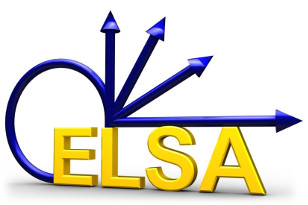The Electron Stretcher Accelerator

|
Address Physikalisches Institut der Universität Bonn Nußallee 12 D-53115 Bonn Germany |
Board of directors Prof. K. Desch (chair) Prof. J. Dingfelder Prof. M. Köhl Prof. N. Wermes |
Contact person Dr. D. Proft Tel.: +49 228 73-3601 Mail: proft@physik.uni-bonn.de |
The Electron Stretcher Accelerator ELSA is operated by the University of Bonn of the state Nordrhein-Westfalen. It consists of three stages (injector LINAC, booster synchrotron and stretcher ring) and provides a beam of polarized and unpolarized electrons with a tunable energy of up to 3.5 GeV. Internally a beam of 200 mA can be stored and was formerly used to deliver synchrotron radiation for material research and condensed matter physics. For the main research field of hadron physics currents of several nA can be extracted and sent to different experimental areas.
In national and international collaborations highly sophisticated large acceptance detectors for the spectroscopy of photo- and electro-produced final states have been set up: Crystal Barrel with TAPS and BGO-Ball with magnetic spectrometer. Leading expertise exists (locally and at collaborators) in the construction and operation of polarized solid state targets. This allows the realization of highly selective double-polarization experiments, which study the excitation of baryon resonances by high-energetic photons. The ELSA facility was the central experimental tool of the Collaborative Research Centre 16 (Subnuclear Structure of Matter) of the DFG, which studied experimentally and theoretically the properties of baryon resonances.
Since end of 2016 a dedicated beam line is available for the test of high energy detectors, providing a direct electron beam with a maximum energy of 3.2 GeV. The extracted current can be varied in a wide range from atto ampere (a few kHz electron rate) up to 100 pA.
Hadron physics experiments
|
Polarized target | ||
| DFG Collaborative Research Centre 16: Subnuclear Structure of Matter | |||
| Last change: F. Frommberger - March 12, 2019 |  Deutsche Version
Deutsche Version |
Imprint | Data privacy statement |